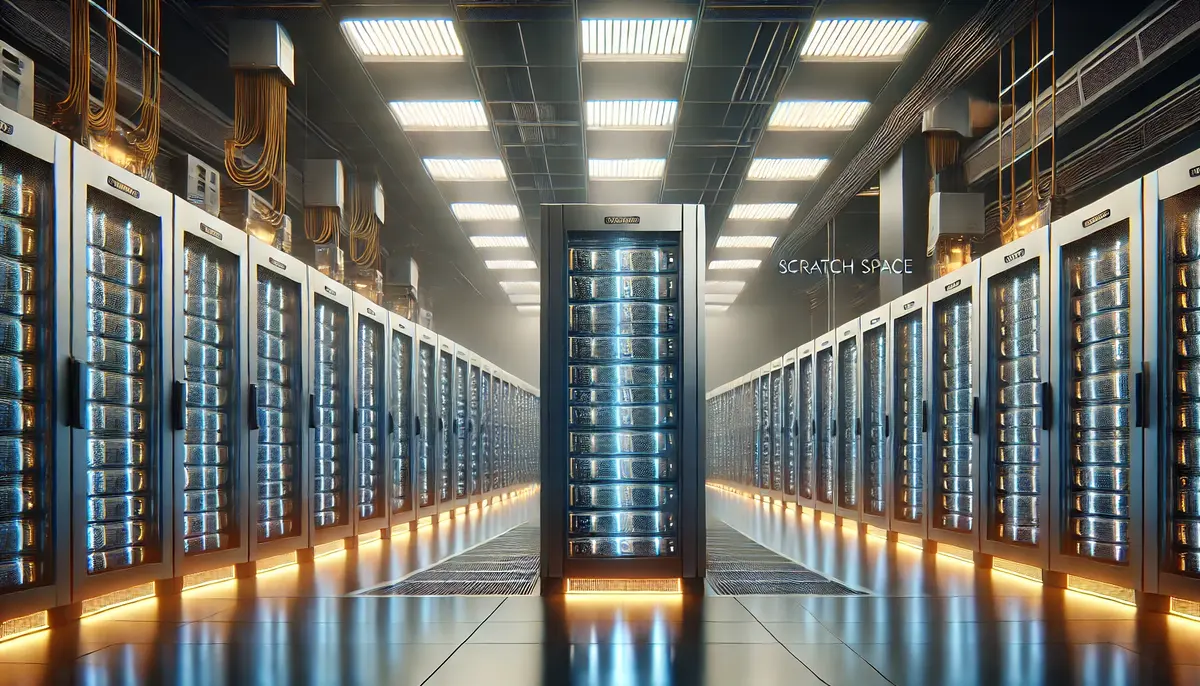In High-Performance Computing (HPC), most of the attention is focused on compute: faster CPUs, cutting-edge GPUs, and ever-denser clusters. But no matter how powerful the processors are, they are ultimately limited by I/O. Data must move in and out—fast, often in parallel, and usually at scale. This is where scratch space comes into play.
Scratch space is one of the most critical, yet misunderstood, components of an HPC storage hierarchy. It’s not persistent, it’s not archival, and it’s not general-purpose—but without it, many large-scale computations would grind to a halt.
What is Scratch Space?
Scratch space is a high-speed, temporary storage area used to hold intermediate data generated during computational jobs. It acts as a working buffer for simulations, training runs, render pipelines, and other performance-intensive workloads. Once the job completes, the data in scratch space is typically discarded, either automatically or by design.
In traditional terms, it’s akin to a scratchpad memory—you use it to jot down what’s needed while thinking, then erase it when you are done.
Key characteristics include:
- High-throughput parallel access (multi-node, multi-threaded I/O)
- Short retention windows, often tied to job scheduling
- No backup or replication
- Automated or policy-driven cleanup mechanisms
The architecture may involve parallel file systems (e.g., GPFS, Lustre, BeeGFS), NVMe or SSD-backed pools, and advanced data movement logic to support bursty, high-volume I/O without polluting persistent storage systems. Though scratch space often shares the same underlying filesystem (like GPFS) as other storage tiers, it is configured and managed separately, with aggressive tuning for metadata performance, concurrency, and short-lived access patterns.

Types of Scratch Space in HPC Systems
Local Scratch (Node-Attached)
- Located on NVMe/SSD inside compute nodes
- Extremely fast, but ephemeral and isolated
- Useful for single-node workloads or caching
Shared Scratch (Parallel File System)
- Backed by high-speed shared storage
- Mounted cluster-wide for cross-node access
- Built using file systems like GPFS, Lustre, BeeGFS
- Supports massive, concurrent access patterns
Burst Buffers
- Memory or flash-based layer in front of scratch or persistent storage
- Used for write-back caching during burst I/O phases
- Often integrated via job schedulers or middleware
How Scratch Differs from Other Storage Layers
| Feature | Scratch Space | Persistent Storage | Archive / Cold Storage |
|---|---|---|---|
| Retention | Hours to days (ephemeral) | Weeks to years | Years+ |
| Performance Focus | Maximum IOPS / bandwidth | Balanced performance / cost | Low cost, low performance |
| Durability | No redundancy or backup | Replicated, fault-tolerant | Often tape-based, offsite |
| Lifecycle Management | Time-to-live (TTL), job-coupled purge | User- or policy-defined | Long-term retention policies |
| Access Pattern | High-churn, multi-process | Mixed I/O types | Sequential reads (mostly) |
Technical Requirements for Scratch Space
To meet the demands of modern HPC workloads, scratch storage must support:
- Parallel I/O at scale: concurrent access from thousands of threads/nodes
- Low metadata latency: fast create/delete operations for small files
- Optimized striping and distribution: for large, sequential or unaligned access
- QoS enforcement and I/O throttling: to prevent job interference
- Automated data eviction: TTLs, job-end hooks, and orphan sweeps
In environments where GPFS or Lustre is used, scratch space is typically deployed as a dedicated pool or file system namespace, separate from user directories or project volumes. This allows for fine-grained tuning of block sizes, caching behavior, and failure domains.
Example Use Cases for Scratch Storage in HPC
These are just examples of how different industries use scratch storage to speed up heavy computing tasks:
- Scientific Simulations (CFD, FEA, molecular dynamics): Write massive checkpoint data and intermediate states.
- Genomic Workflows: Stage and process BAM/FASTQ files at scale.
- AI/ML Training Pipelines: Cache preprocessed datasets, shard files, or log outputs.
- Rendering and VFX: Store temporary frames, asset caches, and compositing layers.
- Climate and Weather Models: Handle timestep data, I/O burst logging, and restart files.
- Seismic Imaging: Store intermediate wavefield data and processed gathers during inversion workflows.
- Financial Risk Modeling: Handle large matrix transformations, cache intermediate risk scenarios, and stress test data.
Challenges in Managing Scratch Space
Despite its speed and purpose-specific design, scratch space presents several operational challenges:
- Capacity Sprawl: Orphaned or lingering files can consume critical space
- Performance Contention: Multi-user environments risk noisy-neighbor effects
- Monitoring Complexity: Transient data makes usage tracking more difficult
- Metadata Overhead: Millions of small files stress file system performance
- User Misuse: Using scratch as pseudo-persistent storage leads to data loss and policy violations
Solving these requires integration with job schedulers, monitoring tools, and data lifecycle automation.
Scratch Space: A Strategic Layer in the HPC Stack
Scratch space is not just a temporary disk—it is a performance-critical infrastructure layer that supports the demanding I/O characteristics of HPC workloads. When properly designed and managed, it ensures that computational resources are not bottlenecked by data movement, and that persistent storage layers remain focused on what they do best: long-term data management.
In modern architectures, scratch space deserves as much design attention as compute and memory. Its effectiveness directly impacts job throughput, resource utilization, and total cost of operation.
How DataCore Can Help
As HPC environments scale, scratch space must do more than provide raw IOPS—it must be policy-driven, resilient under pressure, and seamlessly integrated into the broader storage fabric. Managing high-velocity, temporary data requires a platform that can handle parallel I/O at scale while enforcing retention, access, and cleanup policies without manual overhead.
DataCore Nexus, built on the performance foundation of Pixstor and the data orchestration of Ngenea, delivers exactly that. Pixstor ensures ultra-fast, parallel scratch I/O with consistent performance across thousands of nodes, while Ngenea enables automated data movement between scratch, persistent, and archival tiers. Together, they unify scratch space into a dynamic, scalable, and intelligent HPC storage purpose-built to accelerate high-throughput workloads and streamline data management.